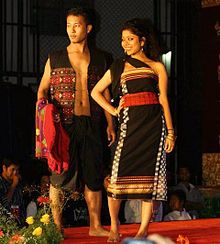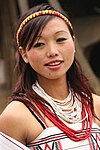Thadou people
 Thadou man and woman in traditional dress | |
| Total population | |
|---|---|
| 229,000–313,000 in India[1] | |
| Regions with significant populations | |
| India, Myanmar and Bangladesh | Manipur, Nagaland, Assam, Mizoram, Tripura |
| Languages | |
| Thadou | |
| Religion | |
| Predominantly Protestantism (Baptist) and Catholicism; very small minority Judaism (Bnei Menashe) | |
| Related ethnic groups | |
| Zo people · Chin · Kuki · Mara · Bnei Menashe, Ranglong · Mizo | |
Thadou people, also called Thadou Kukis, are the Thadou language-speaking Kuki people inhabiting Northeast India, Burma, and Bangladesh. "Thadou" is also the name of a particular clan among the Thadou Kukis. Other clans include Haokip, Kipgen, Doungel, Hangshing, Mangvung etc.[2][3][4]
Identity
[edit]The issues of identity with reference to "Thadou" are complex, since Thadou is the name of a clan (originating from an ancestor called Thadou), and also the name of a language spoken by many other clans unrelated to Thadou or "senior" to Thadou.[5] There is a tendency to refer to all Thadou language-speakers as "Thadous", as if they form a tribe called "Thadou". But this is resented by some of the other clans. There is nothing to suggest that the entirety of Thadou language-speakers ever organised themselves as a tribe. The Gazeetteer of Manipur noted that the Kukis, in particular the Thadou Kukis, were organised in terms of clans rather than tribes.[6]
Prior to the arrival of the British, the Manipuris referred to the Thadou Kukis as "Khongjais".[7] The British replaced this term by "Kukis", which was accepted by Thadou Kukis without reservation, even though the term applied equally to all Kuki-Chin language-speaking people (now referred to as Kuki-Zo people).
Many Thadou language-speakers simply refer to themselves as "Kukis". Some also refer to their language as "Kuki" instead of "Thadou".[8] The correct terminology remains a matter of continuing debate.
Distribution
[edit]According to the 2011 census of India, there are 229,340 Thadou language-speakers in the country. The vast majority of them (97.6%) are in the state of Manipur.[9] Within Manipur, the Thadou Kukis make up the largest single tribal group, forming about 19% of all its Scheduled Tribes.[10] There are also significant numbers of Thadou-speakers in Meghalaya and Assam.[9]
In addition, many Thadou language-speakers are also believed to list their language as "Kuki" in the census.[11] The 2011 census lists 83,968 "Kuki" language-speakers, who are mostly distributed in the states of Nagaland, Manipur and Assam.[12]
References
[edit]- ^ Census of India, Language (2018), pp. 40, 48.
- ^ Shaw, William (1929), Notes on the Thadou Kukis, Government of Assam – via archive.org
- ^ Seilen Haokip, What Price, Twenty Years of Peace (2012), p. 95.
- ^ Ngamkhohao Haokip, Politics of Tribe Identity (2012).
- ^ Haokip, Genesis of Kuki Autonomy Movement (2012), pp.54–55: "The recognition of Thadou as a Scheduled Tribe in 1956 came to be regarded as an usurpation of tradition by various Thadou speaking groups of clans like Lenthang, Lunkim, Changsan, Thangeo, Doungel, etc. who are senior to Thadou in genealogical lineage.".
- ^ Dun, Gazetteer of Manipur (1886), p. 32: 'The word "clan" is undoubtedly the best to apply to the Kuki subdivisions. It is evident from the genealogies of their chiefs, which have been preserved from the earlier times, that each clan has simply called itself after the name of its chief, and the process may be observed going on at the present day.'.
- ^ Michael Haokip, Kuki-Naga Conflict (2007), note 2: "Thadou Kukis were also known as Khongsai [Khongjai] in the past.".
- ^ Haokip, Genesis of Kuki Autonomy Movement (2012), pp.54–55: 'In opposition to the naming of the dialect in question as “Thadou language”, a translation of the Bible in vernacular by T. Lunkim was published in 1971 and named as “Kuki Holy Bible".'.
- ^ a b Census of India, Language (2018), p. 48.
- ^ Michaud, Jean; Swain, Margaret Byrne; Barkataki-Ruscheweyh, Meenaxi (2016), Historical Dictionary of the Peoples of the Southeast Asian Massif (2nd ed.), Rowman & Littlefield, p. 244, ISBN 9781442272798
- ^ Ngamkhohao Haokip, Politics of Tribe Identity (2012), pp. 67–68.
- ^ Census of India, Language (2018), p. 40.
Bibliography
[edit]- Language: India, States and Union Territories (Table C-16) (PDF), Registrar General of India, 2018
- Haokip, Seilen (2012), "What Price, Twenty Years of Peace in Mizoram (1986–2006): A Kuki Perspective", in Thongkholal Haokip (ed.), The Kukis of Northeast India: Politics and Culture, Bookwell, pp. 89–, ISBN 9789380574448
- Haokip, Ngamkhohao (2012), "Politics of Tribe Identity with reference to the Kukis", Journal of North East India Studies, 2 (2): 64–73 – via academia.edu
- Lieut. R. Stewart in the Journal of the Asiatic Society of Bengal (1857). entitled "A slight notice of the Grammar of Thadou or New Kookie language."
External links
[edit]- www
.ethnologue .com /language /tcz - The Thadous at the Wayback Machine (archived December 2, 2021)
- thadoubaptistassociation
.org /en /home

